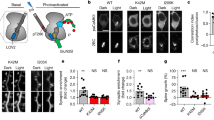Abstract
Long-term potentiation (LTP) is thought to be critically involved not only in learning and memory, but also during the activity-dependent developmental phases of neural circuit formation and refinement1,2. Whether the mechanisms underlying LTP change during this phase of postnatal development, however, is unknown. We report here that, unlike LTP in the more mature CA1 region of the hippocampus, LTP in neonatal rodent hippocampus (<9 postnatal days, <P9) requires cyclic AMP–dependent protein kinase A (PKA) but not Ca2+/calmodulin-dependent protein kinase II (CaMKII).


Similar content being viewed by others
References
Katz, L.C. & Shatz, C.J. Science 274, 1133–1138 (1996).
Constantine-Paton, M. & Cline, H.T. Curr. Opin. Neurobiol. 8, 139–148 (1998).
Malenka, R.C. & Nicoll, R.A. Science 285, 1870–1874 (1999).
Lisman, J., Schulman, H. & Cline, H. Nat. Rev. Neurosci. 3, 175–190 (2002).
Kelly, P.T. & Vernon, P. Develop. Brain Res. 18, 211–224 (1985).
Chang, B.H., Mukherji, S. & Soderling, T.R. Proc. Natl. Acad. Sci. USA 95, 10890–10895 (1998).
Giese, K.P., Fedorov, N.B., Filipkowski, R.K. & Silva, A.J. Science 279, 870–873 (1998).
Adams, J.P. & Sweatt, J.D. Annu. Rev. Pharmacol. Toxicol. 42, 135–163 (2002).
Blitzer, R.D., Wong, T., Nouranifar, R., Iyengar, R. & Landau, E.M. Neuron 15, 1403–1414 (1995).
Chavez-Noriega, L.E. & Stevens, C.F. J. Neurosci. 14, 310–317 (1994).
Chetkovich, D.M. & Sweatt, J.D. J. Neurochem. 61, 1933–1942 (1993).
Rosenberg, G.B., Minocherhomjee, A. & Storm, D.R. Meth. Enzymol. 139, 776–791 (1987).
Fiala, J.C., Feinberg, M., Popov, V. & Harris, K.M. J. Neurosci. 18, 8900–8911 (1998).
Harris, K.M. & Kater, S.B. Annu. Rev. Neurosci. 17, 341–371 (1994).
Tao, H.W., Zhang, L.I., Engert, F. & Poo, M. Neuron 31, 569–580 (2001).
Author information
Authors and Affiliations
Corresponding author
Ethics declarations
Competing interests
The authors declare no competing financial interests.
Supplementary information
Supplementary Fig. 1.
LTP is present at thalamocortical synapses in CaMKII(T286A) mutant mice. (a) Graph showing changes in neocortical CaMKII activity as a function of postnatal age. Values are expressed as a percentage of adult activity (>P60). (b) Example of LTP at thalamocortical synapses onto a layer IV neuron in P5 barrel cortex from a homozygous mutant animal. Inset shows sample EPSCs before and after pairing. (Calibration bars: 10 pA, 10 msec) (c) Summary of LTP at thalamocortical synapses in P4-7 homozygote CaMKII(T286A) mice (n=7). (d) Comparison of LTP magnitude in wild-type mice (n=34; some data from2), heterozygote CaMKII(T286A) mutant mice (n=3) and homozygote CaMKII(T286A) mutant mice (n=7). (GIF 8 kb)
Supplementary Fig. 2.
P42/44 MAPK is required for LTP in mature but not in neonatal hippocampus. (a) Example (1) and summary (2) of effects of the p42/44 MAPK cascade inhibitor PD98059 on LTP in P7-8 hippocampus (Control, n=7; PD98059, n=8). (b) Example (1) and summary (2) of effects of PD98059 on LTP in P>27 hippocampus (Control, n=6; PD98059, n=5). (GIF 11 kb)
Supplementary Fig. 3.
PKA activation increases mEPSC amplitude in neonatal but not in mature hippocampus. (a) Example of mEPSCs before and after forskolin treatment in P7 and P27 hippocampus. Four consecutive traces in each condition are shown (Calibration bars; 20 pA, 1 sec). (b) Averaged mEPSC (n=300-500) before and after forskolin treatment. (c) Summary of effects of forskolin on frequency and amplitude of mEPSCs in P7,8 and >P26 hippocampus. (PDF 593 kb)
Rights and permissions
About this article
Cite this article
Yasuda, H., Barth, A., Stellwagen, D. et al. A developmental switch in the signaling cascades for LTP induction. Nat Neurosci 6, 15–16 (2003). https://doi.org/10.1038/nn985
Received:
Accepted:
Published:
Issue Date:
DOI: https://doi.org/10.1038/nn985
- Springer Nature America, Inc.
This article is cited by
-
Involvement of Cdk5 activating subunit p35 in synaptic plasticity in excitatory and inhibitory neurons
Molecular Brain (2022)
-
The Role of AMPARs Composition and Trafficking in Synaptic Plasticity and Diseases
Cellular and Molecular Neurobiology (2022)
-
PKA-RIIβ autophosphorylation modulates PKA activity and seizure phenotypes in mice
Communications Biology (2021)
-
The Na+-activated K+ channel Slack contributes to synaptic development and plasticity
Cellular and Molecular Life Sciences (2021)
-
PKN1 promotes synapse maturation by inhibiting mGluR-dependent silencing through neuronal glutamate transporter activation
Communications Biology (2020)





